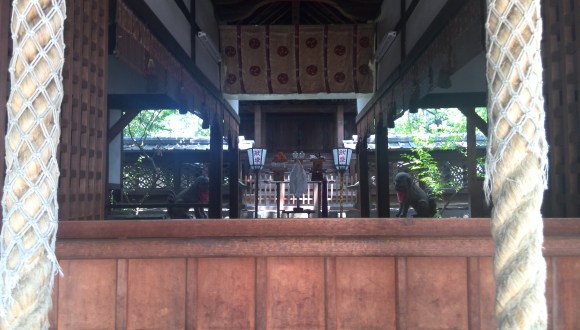
In Japan, there’s a saying that goes: “Japanese people are born into Shintoism, get married as Christians and die as Buddhists.” Usually it’s meant to be a comment on Japan’s laissez-faire attitude towards religion. However, having experienced all three of these life events in Japan, it’s a surprisingly accurate aphorism.
In the case of birth, after one month it’s common practice in Japan to take the baby a Shinto shrine for its Hatsumiyamairi (literally “first shrine visit”) often shortened to Omiyamairi. Like weddings and funerals, these ceremonies can differ greatly depending on the region, so I thought I’d share my own recent experience at an Omiyamairi to shed some light on this lesser-known Japanese tradition.
■ Making reservations
According to tradition the ceremony should be held 31 or 32 days after a boy is born and 32 or 33 days after a girl is born. However, this is not a strict rule at all and can be done any day depending on things like the weather or health of mother and child.
We made an appointment at a nearby shrine ahead of time. Often the price of the ceremony is listed somewhere on the shrine grounds. Depending on the shrine prices can vary from 3,000 yen to 10,000 yen (US$30-$100).
■ What to wear
Before entering the temple we had to get baby dressed. The rest of us just wore regular formal attire (suits etc.) but the baby had to wear a special bonnet and bib like collar that we rented from a photo studio. Since she’s a girl they were brightly colored pink and festively decorated. Then a type of kimono is draped over the baby and tied behind the back of the person holding her.
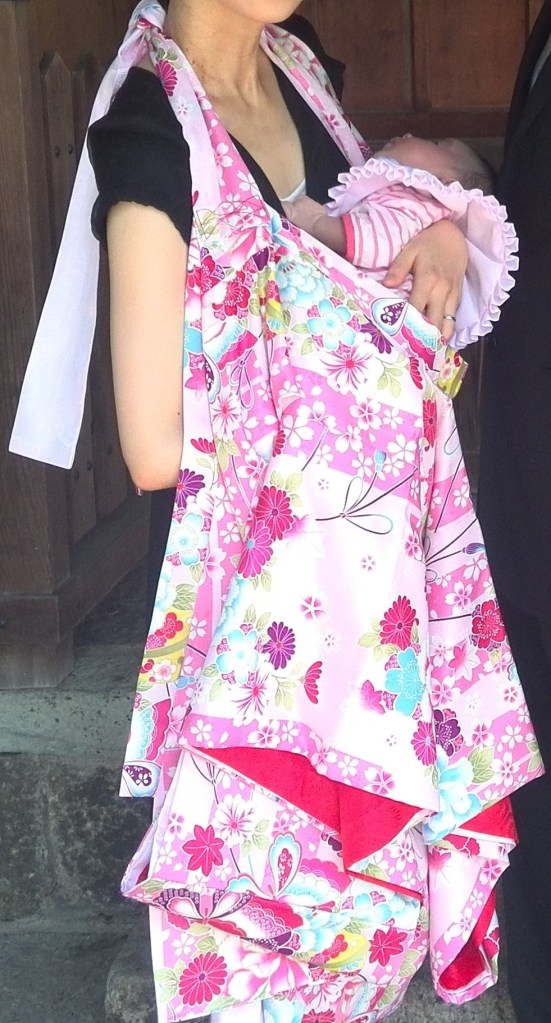
To complete the look, a kanji character is drawn on the forehead of the baby. This is surprisingly tricky as I learned that babies don’t seem to like people drawing on their heads and wriggle around quite a bit! It’s said that baby boys get a 大 (big) character to wish that they grow up big and strong, whereas girls get a 小 (small) to hope that they are delicate and modest.
Traditionally the father’s mother is supposed to hold the baby. In Japan, the postpartum is treated very delicately and mothers are encouraged to rest as much as possible during one month after childbirth so those duties were passed on to someone else. This isn’t really a strict custom any more either, and pretty much anyone who wants to can hold the baby.
■ Into the shrine
Like every day recently it was an especially hot and sunny day, but walking into the shrine it was surprisingly cool and comfortable. A Shinto priest greeted us inside. He was dressed in an orange robe similar to a kimono and a pointed black hat.
First the priest knelt on the tatami mat with his back to us in front of an altar with several items on top like oranges and sake. He began to chant for a couple minutes intermittently clapping loudly. I couldn’t make out what he was saying but I heard our names at one point. He seemed to stutter for a moment before saying my foreign name but it could have just been the rhythm of the chant.
■ The purification
He was also holding a flat wooden stick kind of like a large shoehorn. I later learned this was a shaku which was once an accessory in formal attire but is now only used by Shinto priests. This priest would occasionally put down the shaku and begin repositioning it in precise positions but very quickly. He would then pick it up and hold it vertically as he continued to chant.
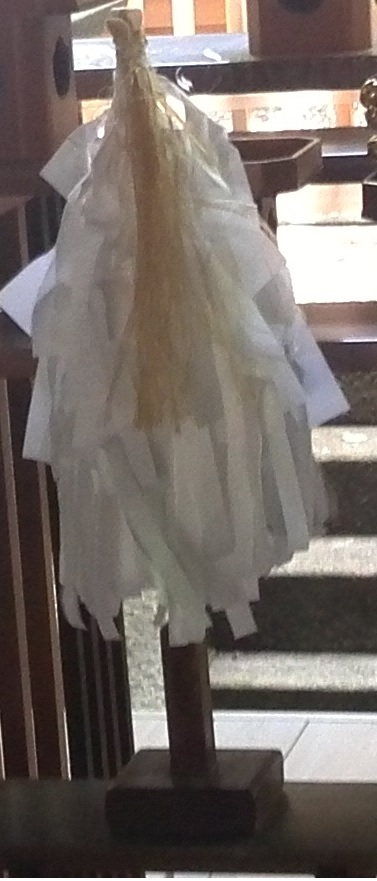
After another round of chanting the priest got up again and picked up another stick, this time with several bells hanging around it. He brought it close to the baby and began rattling it. I thought it would disturb the baby as it kind of freaked me out a little, but she didn’t seem to mind it at all. Much like the onusa bell-ringing is said to remove evil in Shinto, which I suppose means I’m slightly evil since it startled me a bit.
After another brief chant the priest then congratulated us and we handed over our payment. He gave us a smile and left out the back. The whole ceremony was probably only five to ten minutes long, which is good when you have a one-month old baby! That’s just about the limit they can stay awake without crying.
■ Presents!
As an added bonus the shrine gave us some swag! In the gift bag was a scroll, some sugar packets (no idea why) and a little ceramic snake with a bell in it since this is, of course, the year of the snake. Lucky charms were there too, like an ema, which is a wooden board that you can write a wish on and hang in the shrine to make it come true. There was also an omamori, a lucky card inside a little cloth bag that should never be opened thus torturing the inherently curious.
Finally there was a pair of chopsticks. They’re meant for the baby’s second ceremony which takes place 100 days after she was born, called Okuizomo which celebrates the first time a baby eats solid food. This is actually earlier than when babies can eat food so we just kind of pretend they can. They could change it, but why mess with tradition?
So, for the next few years my baby will be building up good luck and spiritual purification as a Shintoist. Meanwhile, I can dream of the day she becomes a happily married Christian (if it’s still in vogue in at that time), and hope that I never, ever have to see her become a Buddhist.
Photos: RocketNews24

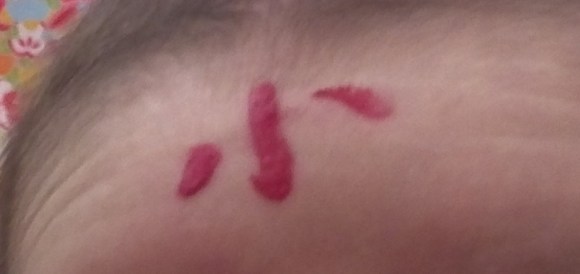
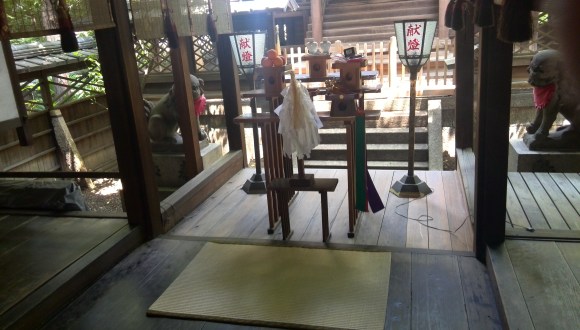
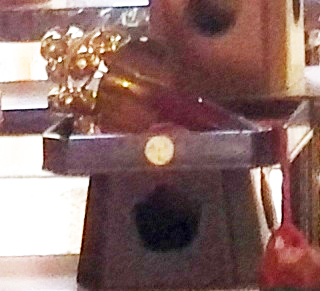
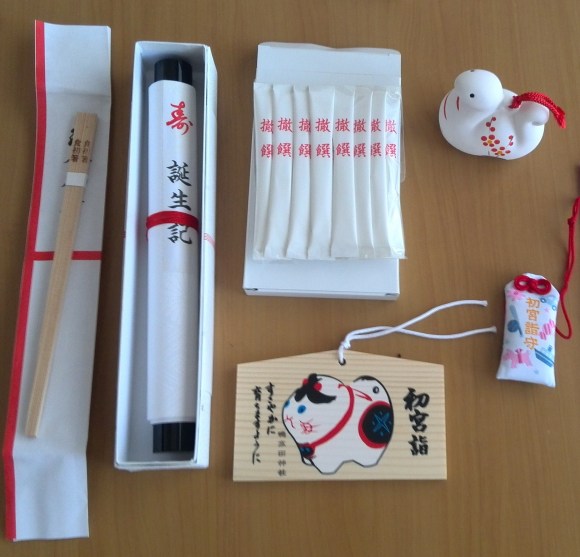

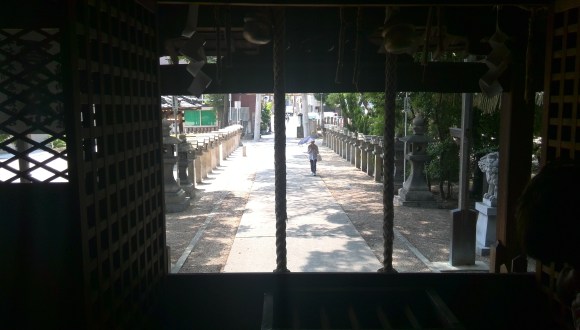
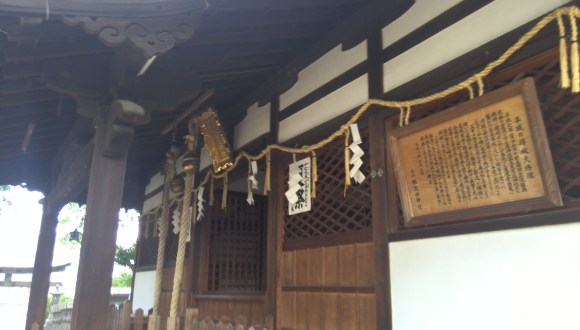
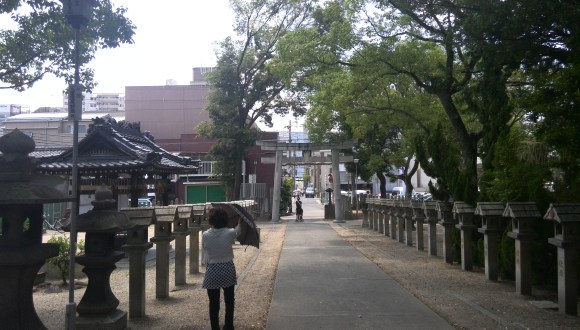
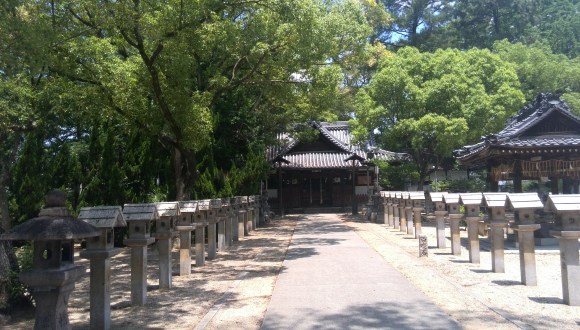
 Is it OK to buy multiple shrine charms in Japan, or will it make the gods angry at you?
Is it OK to buy multiple shrine charms in Japan, or will it make the gods angry at you? Burn baby burn! The Shinto inferno of Japan’s Dondo Yaki ceremony
Burn baby burn! The Shinto inferno of Japan’s Dondo Yaki ceremony Japanese Buddhism in 10 minutes【Rocketpedia】
Japanese Buddhism in 10 minutes【Rocketpedia】 Japanese “Exorcism Holiday Plan” for dogs helps rid them of bad spirits in their unlucky years
Japanese “Exorcism Holiday Plan” for dogs helps rid them of bad spirits in their unlucky years The most crowded place in Tokyo? Might be the Kanda Matsuri festival, but it’s still awesome
The most crowded place in Tokyo? Might be the Kanda Matsuri festival, but it’s still awesome Ramen restaurant’s English menu prices are nearly double its Japanese ones, denies discriminating
Ramen restaurant’s English menu prices are nearly double its Japanese ones, denies discriminating Here’s what our bachelor writers ate over the New Year’s holiday in Japan
Here’s what our bachelor writers ate over the New Year’s holiday in Japan Is it OK to split the bill on a date in Japan? Survey asks what women and men of different ages think
Is it OK to split the bill on a date in Japan? Survey asks what women and men of different ages think Nearly one in ten young adults living in Japan isn’t ethnically Japanese, statistics show
Nearly one in ten young adults living in Japan isn’t ethnically Japanese, statistics show Kyoto samurai house wants to share its history of seppuku, torture and gold coins with visitors
Kyoto samurai house wants to share its history of seppuku, torture and gold coins with visitors No coins? Not a problem for Japan’s new cashless gachapon capsule toy vending machines
No coins? Not a problem for Japan’s new cashless gachapon capsule toy vending machines How to get a job in anime with Studio Ghibli director Hayao Miyazaki
How to get a job in anime with Studio Ghibli director Hayao Miyazaki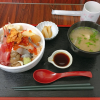 Tsukiji alternative – Tokyo has a second fish market, and it turns out it’s awesome too
Tsukiji alternative – Tokyo has a second fish market, and it turns out it’s awesome too How much difference does the choice of mold make in fermenting food?
How much difference does the choice of mold make in fermenting food? Original Totoro plush toys from 80s and 90s re-issued for Studio Ghibli exhibition
Original Totoro plush toys from 80s and 90s re-issued for Studio Ghibli exhibition Japanese beef bowl chain Sukiya’s 2026 Smile Box lucky bag basically pays for itself
Japanese beef bowl chain Sukiya’s 2026 Smile Box lucky bag basically pays for itself Starbucks Japan ready to get Year of the Horse started with adorable drinkware and plushies【Pics】
Starbucks Japan ready to get Year of the Horse started with adorable drinkware and plushies【Pics】 Hayao Miyazaki says Happy New Year to Studio Ghibli fans with new art for Year of the Horse
Hayao Miyazaki says Happy New Year to Studio Ghibli fans with new art for Year of the Horse Cup Noodle tries an authentic Jiro-style ramen, but something’s not quite right
Cup Noodle tries an authentic Jiro-style ramen, but something’s not quite right Top Japanese cosplayer Enako returns to Comiket after 6 years, creates mayhem with admirers
Top Japanese cosplayer Enako returns to Comiket after 6 years, creates mayhem with admirers The best Starbucks Japan Frappuccinos we want to drink again in 2026
The best Starbucks Japan Frappuccinos we want to drink again in 2026 We revisited Sweets Paradise after a decade to see if Japan’s dessert buffet still delivers
We revisited Sweets Paradise after a decade to see if Japan’s dessert buffet still delivers That time Seiji called JASRAC to ask why he didn’t get paid royalties for his song being on TV
That time Seiji called JASRAC to ask why he didn’t get paid royalties for his song being on TV Pizza Hut Japan’s hot lucky bags are perfect for a New Year’s pizza party
Pizza Hut Japan’s hot lucky bags are perfect for a New Year’s pizza party Majority of Japanese mayors say foreign residents are essential but most see good and bad effects
Majority of Japanese mayors say foreign residents are essential but most see good and bad effects 7-Eleven Japan starts new temporary luggage storage service in over 300 branches
7-Eleven Japan starts new temporary luggage storage service in over 300 branches Disillusionment at Tsukiji’s tourist-target prices led us to a great ramen restaurant in Tokyo
Disillusionment at Tsukiji’s tourist-target prices led us to a great ramen restaurant in Tokyo Starbucks teams up with 166-year-old Kyoto doll maker for Year of the Horse decorations【Photos】
Starbucks teams up with 166-year-old Kyoto doll maker for Year of the Horse decorations【Photos】 Tokyo considering law requiring more trash cans following litter increase in heavily touristed area
Tokyo considering law requiring more trash cans following litter increase in heavily touristed area Tokyo’s Tsukiji sushi neighborhood asks tour groups to stay away for the rest of the month
Tokyo’s Tsukiji sushi neighborhood asks tour groups to stay away for the rest of the month Tokyo event lets you travel back in time, for free, to celebrate 100 years since Showa era start
Tokyo event lets you travel back in time, for free, to celebrate 100 years since Showa era start Japan may add Japanese language proficiency, lifestyle classes to permanent foreign resident requirements
Japan may add Japanese language proficiency, lifestyle classes to permanent foreign resident requirements Sanrio theme park in Japan announces plans to expand into a Sanrio resort
Sanrio theme park in Japan announces plans to expand into a Sanrio resort Lacquerware supplier to emperor of Japan and Pokémon team up for new tableware
Lacquerware supplier to emperor of Japan and Pokémon team up for new tableware Survey asks foreign tourists what bothered them in Japan, more than half gave same answer
Survey asks foreign tourists what bothered them in Japan, more than half gave same answer Japan’s human washing machines will go on sale to general public, demos to be held in Tokyo
Japan’s human washing machines will go on sale to general public, demos to be held in Tokyo Japan’s deadliest food claims more victims, but why do people keep eating it for New Year’s?
Japan’s deadliest food claims more victims, but why do people keep eating it for New Year’s? We deeply regret going into this tunnel on our walk in the mountains of Japan
We deeply regret going into this tunnel on our walk in the mountains of Japan Studio Ghibli releases Kodama forest spirits from Princess Mononoke to light up your home
Studio Ghibli releases Kodama forest spirits from Princess Mononoke to light up your home Major Japanese hotel chain says reservations via overseas booking sites may not be valid
Major Japanese hotel chain says reservations via overseas booking sites may not be valid Put sesame oil in your coffee? Japanese maker says it’s the best way to start your day【Taste test】
Put sesame oil in your coffee? Japanese maker says it’s the best way to start your day【Taste test】 No more using real katana for tourism activities, Japan’s National Police Agency says
No more using real katana for tourism activities, Japan’s National Police Agency says Starbucks Japan reveals new sakura drinkware collection, inspired by evening cherry blossoms
Starbucks Japan reveals new sakura drinkware collection, inspired by evening cherry blossoms Updated cherry blossom forecast shows extra-long sakura season for Japan this year
Updated cherry blossom forecast shows extra-long sakura season for Japan this year Serial Tree Killer on the Loose in Western Japan, 14 “Sacred Trees” Poisoned So Far
Serial Tree Killer on the Loose in Western Japan, 14 “Sacred Trees” Poisoned So Far Tokyo’s 400-year-old Shinto shrine welcomes Roombas to help with annual susuosame ceremony【Video】
Tokyo’s 400-year-old Shinto shrine welcomes Roombas to help with annual susuosame ceremony【Video】 Real-life Ghost of Tsushima shrine announces ban of all “tourists,” but there’s some fine print
Real-life Ghost of Tsushima shrine announces ban of all “tourists,” but there’s some fine print “Cat shrine” status causing problems for Japan’s millennium-old Izumoiwai Shrine
“Cat shrine” status causing problems for Japan’s millennium-old Izumoiwai Shrine Coronavirus changes how Tokyo shrine handles centuries’ old purification process for visitors
Coronavirus changes how Tokyo shrine handles centuries’ old purification process for visitors Japan’s top 3 rock “power spots”
Japan’s top 3 rock “power spots” A visit to Japan’s priest murder party cliffs of Tojinbo【Photos】
A visit to Japan’s priest murder party cliffs of Tojinbo【Photos】 Japanese voodoo dolls with foreign politician photo keep getting nailed to town’s shrine trees
Japanese voodoo dolls with foreign politician photo keep getting nailed to town’s shrine trees Mist descends upon Japan’s “Killing Stone” after ceremony to appease nine-tailed fox spirit
Mist descends upon Japan’s “Killing Stone” after ceremony to appease nine-tailed fox spirit Crazy Japanese “doctor” thinks babies live in clouds, choose their mothers from the heavens
Crazy Japanese “doctor” thinks babies live in clouds, choose their mothers from the heavens 6 surprising things about having a baby in Japan
6 surprising things about having a baby in Japan Japanese man gets arrested for stealing 30 yen (US 27 cents) from Shinto shrine’s collection box
Japanese man gets arrested for stealing 30 yen (US 27 cents) from Shinto shrine’s collection box Japanese police hide at shrine in camo gear to catch a thief…who stole six bucks 【Video】
Japanese police hide at shrine in camo gear to catch a thief…who stole six bucks 【Video】 With Japan’s day care shortage, how hard is it to bring your baby to work with you? We experiment
With Japan’s day care shortage, how hard is it to bring your baby to work with you? We experiment How Kyoto’s shrine of severing ties helped our reporter escape from a “black company”
How Kyoto’s shrine of severing ties helped our reporter escape from a “black company” A visit to “the most blessed kappa statues in all of Japan”【Photos】
A visit to “the most blessed kappa statues in all of Japan”【Photos】
Leave a Reply